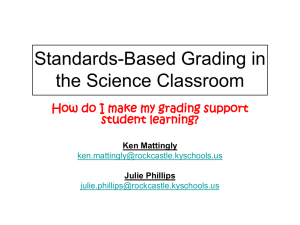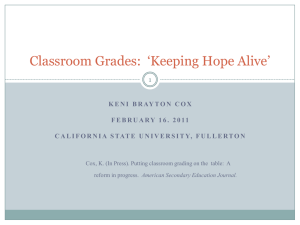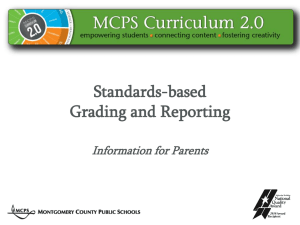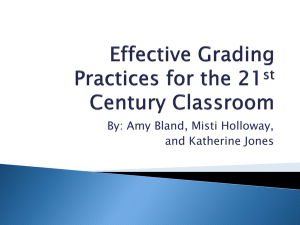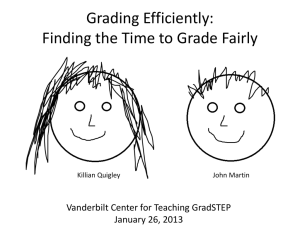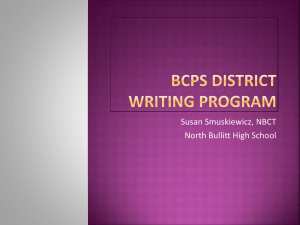Curriculum Institute Moving to standards
advertisement
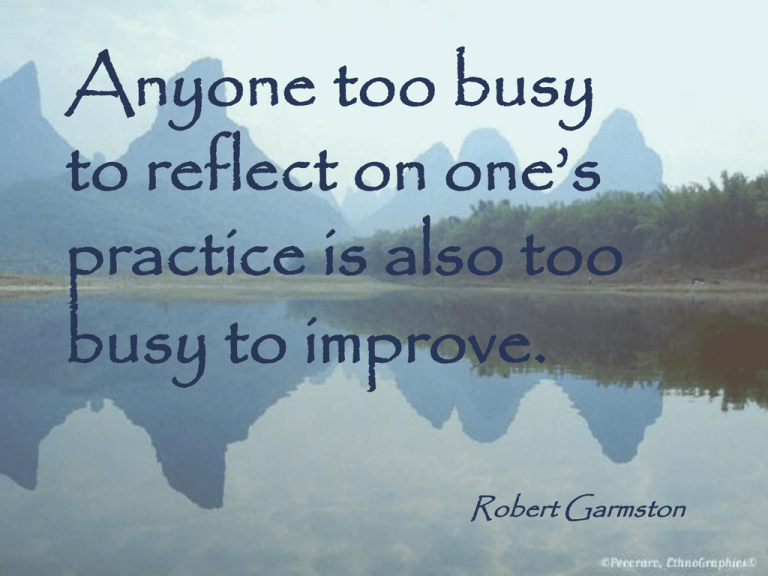
Anyone too busy to reflect Anyone too busy on one’s practice is also too tobusy reflect to improve.on one’s practice is also too busy to improve. Robert Garmston Robert Garmston MOVING TO A STANDARDS-BASED GRADING SYSTEM: LESSONS LEARNED Presented by: Ria A. Schmidt, Ph.D. Standards-Based Grading “If the goal of today’s educational system is to determine when (and if) students have met course standards, should we not be keeping achievement records that match the standards we are expected to teach instead of records that are labeled test, homework, book report, class work, quiz, project, presentation or class participation?” --Bruce Oliver Standards-Based Grading “How confident are you that the grades students receive in your school are consistent, accurate, meaningful, and supportive of learning?” --Ken O’Connor TODAY’S OBJECTIVES Participants will: Identify and discuss the steps for transitioning from traditional grading to a standards-based grading (SBG) system. Connect Common Core to process of planning and implementation of SBG. Receive and utilize practical resources for planning and implementation of SBG. CHANGE All changes, even positive ones, are scary. Attempts to reach goals through radical or revolutionary means often fail because they heighten fear. But the small steps of kaizen ("improvement") disarm the brain’s fear response, stimulating rational thought and creative play. --Robert Maurer Alksjfalskfjslkdfjskdfj slkdj;aa;lkjfa;slkjfsal; sa;kljfsdlks;lkjfsavvv vvvvvvvvvvvvvvvvvv kjs;l Change Toolkit. Reinventingeducation.org. IBM (2002) http://www.reinventingeducation.org/RE3Web/ FIRST VS. SECOND ORDER CHANGE • Have no doubt, transitioning to a SBG is a Second Order Change - “involves dramatic departures from the expected, both in defining a given problem and in finding a solution” (Marzano et al, 2005) or deep change. WHY CHANGE (ESPECIALLY WHEN IT’S SO HARD)? The answers are quite simple: 21st Century Learner WHY CHANGE (ESPECIALLY WHEN IT’S SO HARD)? The answers are quite simple: WHY CHANGE (ESPECIALLY WHEN IT’S SO HARD)? The answers are quite simple: “Grades are so imprecise that they are almost meaningless.” Marzano, R. J. (2000) SMALL STEPS It is better to take many small steps in the right direction than to make a great leap forward only to stumble backward.” --Old Chinese Proverb SO WHERE DO WE BEGIN . . . Start wherever you are and start small. --Rita Bailey SO WHERE DO WE BEGIN . . . A vision . . . . . . is a clearly stated, achievable, even optimistic organizational aspiration. . . . needs to paint a picture of a brighter, better future for all school stakeholders (teachers, staff, and students). SO WHERE DO WE BEGIN . . . What is your philosophy of grading or vision? You may want to consider: Why we grade students: Motivation? Communication? Honor roll/High Honors? To get them ready for the next level? Determine placement? Accountability? BEGIN WITH A VISION Take a few minutes to write a draft of your philosophy of grading or vision . . . In our school/district, a grade represents a clear and accurate indicator of what a student knows and is able to do. With grades, we document the progress of students and our teaching, we provide feedback to students and their parents, and we make instructional decisions regarding the students. IMPORTANCE OF LEADERSHIP Leadership responsibilities: 1) Know effects of change and provide vision IMPORTANCE OF LEADERSHIP Leadership responsibilities: 2) Drive and Motivate IMPORTANCE OF LEADERSHIP Leadership responsibilities: 3) Know theory and research SHARING INFORMATION • Throughout entire process . . . with EVERYONE • Continual education/professional development for EVERYONE WHO IS EVERYONE? • • • • • • • • • Board of Education Administrators Teachers Instructional Staff Staff Parents Students Community Members Anyone else not mentioned here who is involved in school/district IMPORTANCE OF LEADERSHIP Leadership responsibilities: 4) Take a risk/challenge the status quo • “Why fix it when it ain’t broken!” • . IMPORTANCE OF LEADERSHIP Leadership responsibilities: 5) Evaluation • Data • Hard • Anecdotal IMPORTANCE OF LEADERSHIP Leadership responsibilities: 6) Be like Gumby • Flexible • Open to input STEP 1: DEVELOP A TIMELINE 2010-2011: Deconstruct Common Core 2011-2012: Professional Development on Standards-based Grading Philosophy Create SBG Committee 2012-2013: Continued Professional Development Develop format for report card “ON TARGET” Students can hit any target they can see and which stands still for them. (Stiggins, R.) STEP 2: DECONSTRUCTING THE COMMON CORE Things to keep in mind: Keep the content to what can actually be taught in the time you have. Should be written in a way that enhances classroom instruction and assessment. Must be measureable Must be unidimensional STEP 2: DECONSTRUCTING THE COMMON CORE Begin by creating a content area (e.g., ELA) committee of teachers and administrators Divide the committee into grade bands, such as: K-2, 3-5, 6-8 Provide resources Professional development Technology STEP 2: DECONSTRUCTING THE COMMON CORE Questions to ask: What must students know? What must students be able to do? STEP 2: DECONSTRUCTING THE COMMON CORE Knowledge Reasoning Performance/skills Products Reading Standards for Informational Text K–5; Key Ideas and Details Grade 5 : Determine two or more main ideas of a text and explain how they are supported by key details; summarize the text. Learning Targets: Knowledge Targets Reasoning Targets Understand the Analyze the concepts of themes and main idea and main ideas of a key details work considering its Identify main audience and ideas and key Purpose details in text Skill Targets Explain how Key details support main Ideas Summarize Text Product Targets Grade 3: Blooms Grade 4: Blooms Grade 5: Blooms Reading/Literature: Students will read and respond to a wide range of writing to build an understanding of written materials of themselves, and of others. Use effective reading strategies to achieve their purposes in reading. Apply word 3 Use word recognition recognition skills skills such as analyzing such as rereading word structures. and applying letter-sound relationships, including vowel sounds, medial sounds, consonant blends, and consonant digraphs. 3 Apply word recognition 3 skills to increase vocabulary through the study of multiple meanings, context clues, and word structure. Grade 3: Blooms Interprets how illustrations convey the meaning of text. Break down words into components such as root words, prefixes and suffixes. Grade 4: Blooms Grade 5: Blooms 4 Analyze how 4 Understand and use 3 illustrations, graphs, and visual aids such as maps support written graphs and maps. text. 4 Infer the meaning of 4 Apply knowledge of 3 unfamiliar words by sentence and word examining known words meanings to and phrases, including understand unfamiliar roots, prefixes and words and clarify suffixes. passages. Find the meaning 3 Apply phonemic 3 Use text format such as 3 of unfamiliar awareness by boldfaced print, causewords by pronouncing and and-effect and identifying known understanding sequence of events as words and using unfamiliar words and aids to comprehension. phonemic text. awareness. “I never teach my pupils; I only attempt to provide the conditions in which they can learn.” --Albert Einstein STEP 3: DEVELOP GUIDELINES • differentiation • separate behavior and academic grades • purposeful homework • formative assessments/feedback • averaging • late work/incompletes • extra credit • zeroes • multiple summative assessments GRADING/ASSESSMENT GUIDELINES Differentiation GRADING/ASSESSMENT GUIDELINES Separate behavior and academics GRADING/ASSESSMENT GUIDELINES Homework Purposeful Graded? "Think left, and think right, and think low, and think high. Oh the thinks you can think if only you try." ~Dr. Seuss GRADING/ASSESSMENT GUIDELINES Averaging “Not everything that counts can be counted, and not everything that can be counted counts.” --Albert Einstein GRADING/ASSESSMENT GUIDELINES Late work/incompletes St. Theresa 6th Grade Comparison # of late assignments 100 90 80 70 60 50 40 30 2nd quarter 3rd quarter 4th quarter Terms Before New Policy (2003-2004) After New Policy (2004-2005) St. Theresa 7th Grade Comparison 170 # of late assignments 160 150 140 130 120 110 100 90 80 70 60 2nd quarter 3rd quarter 4th quarter Terms Before New Policy (2003-2004) After New Policy (2004-2005) GRADING/ASSESSMENT GUIDELINES Extra credit “Don’t give points for extra credit or use bonus points; seek only evidence that more work has resulted in a higher level of achievement.” O’Connor, K. (2010) GRADING/ASSESSMENT GUIDELINES Traditional Scale % Points Total 91-100 81-90 71-80 61-70 Zero-60 10 points 10 points 10 points 10 points 60 points (A) (B) (C) (D) (F) GRADING/ASSESSMENT GUIDELINES Zeroes On a traditional scale, the % range for each level is 10% Teachers will use “I.D.” (insufficient data) on the progress report. GRADING/ASSESSMENT GUIDELINES Formative assessment/Feedback Multiple summative assessments FORMATIVE/SUMMATIVE FLOW CHART The Role of Formative and Summative Assessment Enrichment Instruction On New Unit Preassessment Instruction Formative Assessment Further Instruction Summative Assessment Evidence For Evaluation/ Grades Correctives Need for Improvement Figure 4.4 Adapted from Guskey and Bailey 2001, p.98 THE POWER OF ASSESSMENT “You can enhance or destroy students’ desire to succeed in school more quickly and permanently through your use of assessment than with any other tools you have at your disposal.” Rick Stiggins - Assessment Trainers Institute Oral Report Lecture Rock opera Seminar Debate Scenario Play Slogan/jingle Interview Story Play script Manual Telephone conversation Game Book Letter to editor, author, or expert Survey Performance CD-ROM Skit Overheads Poster Docudrama Invention Prototype News program Puppet Show Audio/videotape Demonstration Scrapbook Book cover Manual Artifact Chart Mural Masks Model Photographs Matrices Puzzle Collection Diorama Photo essay Blueprint Brochure Learning center Artistic Creation Illustration Diagram Display Cartoon or comic strip Web Construction Sculpture Vertical file Map Mobile Costume Project Cube Pantomime Proclamation Annotated bibliography Advertisement Timeline Book review/report Document Scroll Pamphlet Experiment Slide Show Visual Diary Computer Program Musical composition Collection Booklet Magazine article Simulation Lesson Report Questionnaire Song Talk show Written Poetry Group anthology Discussion group Choral speech Essay “What if” story Newspaper article Myth/legend GRADING/ASSESSMENT GUIDELINES Pre-assessment Analyze the results Organize Instructional groups Use data to plan and evaluate lessons and give feedback Daily Instruction Observe and monitor Post-assessment Analyze the results and determine next steps Provide Focused Instruction STEP 3: DEVELOP GUIDELINES • differentiation • separate behavior and academic grades • purposeful homework • formative assessments/feedback • averaging • late work/incompletes • extra credit • zeroes • multiple summative assessments STEP 4: CREATE STANDARDSBASED GRADING COMMITTEE • Administrators •Central Office •Building •Teachers •All content areas •All grade levels •Parents •Students STEP 5: PROFESSIONAL DEVELOPMENT • Administrators/Board of Ed Members STEP 5: PROFESSIONAL DEVELOPMENT •Teachers •Opportunities to meet with grade- level peers •Work with grade-level peers to create rubrics for the benchmarks STEP 5: PROFESSIONAL DEVELOPMENT •Parents •Start at the beginning •What is a standard? Benchmark? STEP 5: PROFESSIONAL DEVELOPMENT •Students STEP 6: CREATE REPORT CARD FORMAT •Committee work •How many benchmarks? •Where are 21st Century skills/behavior included? •What symbols for proficiency? •Letter grades? At what levels? PROFICIENCY SCALE EXAMPLE 4 3 2 1 Meets grade level expectation with excellence Meets grade level expectations Progressing towards meeting grade level expectations Not meeting grade level expectations WOW Right on target Getting there Struggling No teacher assistance needed. Student understood concept without teacher help. After teacher explanation and guided practice, student understood concept. Student is beginning to understand concept, but needs a little more guidance. Student does not understand the concept and needs much more guidance STEP 6: CREATE REPORT CARD FORMAT •Feedback •Administrators/Board of Ed •Teachers •Parents •Students STEP 7: PROFESSIONAL DEVELOPMENT •Teachers •Opportunities to meet with grade- level peers •Work with grade-level peers to create rubrics for the benchmarks EXAMPLE LA.S1.B3 Grade 3: Identify the differences between fiction and nonfiction and determine their purpose. (entertain or inform) 4 3 2 Without teacher help, the student knows a fiction text from a non-fiction text and can tell the purpose of the text. After description and guided practice from the teacher, a student can tell if a text is fiction or nonfiction and can explain the purpose (either entertain or inform) With teacher questioning, the student understands the concept of fiction and nonfiction, but still has trouble identifying the purpose of a text 1 The student cannot tell the difference between a fiction and nonfiction text and has no concept of purpose. STEP 8: ROLL OUT REPORT CARD STEP 9: FEEDBACK/EVALUATION Implement report card for three quarters/two trimesters Provide feedback survey/focus groups for: Teachers Parents Students 5a. Do you feel you are receiving more information about your child as a learner from this new progress report? Why or why not? 7a. Do you feel differentiation (meeting the needs of every child by teaching to various skill levels) is happening in your child's classrooms? In what ways? Yes Yes My children have been given additional advanced work to keep them learning & not become bored w/things they already know. Help is still available if needed. No I would to keep scoring the No Meeting the needs of every child is traditional way on the A-F scale. I not possible in classrooms today. believe it tells the whole picture of One teacher cannot meet the my child's performance - not just needs of 20-30 students each day. the school work turned in. The new There are too many levels of progress report is not "real" world. students in traditional classrooms Our bosses aren't going to give us to keep them all challenged all the raises if things are done on time. time. I prefer the "break out" concept where students of different levels go to different teachers for help. They used to do this with the TAG program. STEP 10: REVISE/CONTINUE LAST THOUGHTS . . . “Education would be so much more effective if its purpose were to ensure that by the time they leave school every boy and girl should know how much they don't know, and be imbued with a lifelong desire to know it." --Sir William Haley, British newspaper editor and broadcasting administrator QUESTIONS? REFERENCES Marzano, R.J., Waters, T., & McNulty B.A. (2005). School leadership that works: From research to results. Alexandria, VA: ASCD. O’Connor, K. (2002). How to Grade for Learning: Linking Grades to Standards, 2nd Edition. Boston, MA: Allyn & Bacon. Marzano, R. J. (2000). Transforming Classroom Grading. Alexandria, VA: ASCD. O’Connor, K. (2010). A Repair Kit for Grading: Fifteen Fixes for Broken Grades, 2nd Edition. Wormeli, R. (2006). Fair isn’t always equal: Assessing & Grading in the differentiated classroom. Portland, ME: Stenhouse Publishers. Change Toolkit. Reinventingeducation.org. IBM (2002) http://www.reinventingeducation.org/RE3Web/



